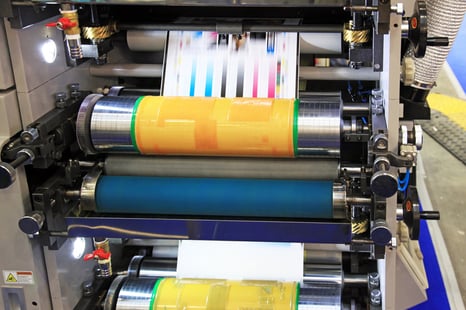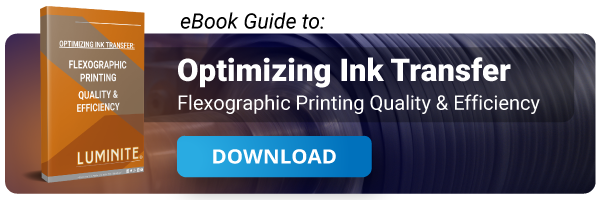Share this
Sustainable Inks for Printing in the Flexo Industry
by Luminite on Jul 24, 2023 11:48:18 AM

The flexographic printing industry is increasingly turning to sustainable inks for their printing needs. Not only are sustainable inks better for the environment, but they offer printers many other advantages as well. Since they are not made with any hazardous materials like solvents or petroleum products, they require less energy and fewer resources overall than conventional ink types during production and use. They also allow printers to reduce costs by eliminating the need for costly hazardous waste disposal services while still achieving superior print results.
Sustainable ink technology offers a variety of benefits that make it an attractive choice for printers looking to achieve better environmental sustainability ratings while still producing excellent-quality prints. By using eco-friendly inks, printers can help reduce their carbon footprint while still meeting consumer demand for high-quality printing results and sustainable packaging materials.
Understanding Flexo Inks
Flexo inks are most commonly made with solvent-based, oil-based, and water-based chemicals. Traditional solvent and oil-based flexo inks contain volatile organic compounds, or VOCs, and other potentially toxic chemicals that can be harmful to the environment both during production and when curing on the substrate.
By switching from traditional petroleum-based inks to more eco-friendly alternatives, the industry is able to reduce its carbon footprint and create packaging that meets the demands of environmentally conscious consumers.
Water-based inks are a popular option, as they contain no Volatile Organic Compounds (VOCs). They can also be easily blended with ingredients like algae cells to create an even more sustainable product. In comparison to solvent-based inks, which release harmful VOCs into the atmosphere during production, water-based inks are a much more sustainable option for the flexo industry.
Water-based flexo inks can also be easily removed from printing equipment with hot water or other biodegradable solvents rather than harsh chemical cleaners. This makes them much easier to maintain and more cost-effective over time compared to traditional solvent and oil-based flexo inks.
The Rise of Algae-Based Inks
One current potential alternative that is gaining popularity is algae-based ink. A company called Living Ink, based in Colorado, has pioneered technology that purifies pigment from algae, which is then milled. A dispersion is created, which then can be used for ink. This ink has recorded several improvements, including longer shelf life, and is seeing a notable level of interest from European companies in particular.
Benefits of Sustainable Inks in Flexo Printing
Using sustainable ink in flexo printing offers many benefits, from reduced environmental impact to cost savings. Not only does it reduce the amount of pollutants released into the air during production and curing, but it also eliminates the need for hazardous chemicals to clean printing equipment. This reduces costs associated with purchasing and disposing of dangerous cleaners. In addition, sustainable ink requires less energy to cure and can be used on a wider variety of substrates, reducing waste and improving efficiency.
Sustainable ink use is also beneficial for workplaces as it helps to create a healthy working environment by eliminating toxic fumes and VOCs in the air that can have long-term health consequences. Furthermore, this type of ink has a longer shelf-life compared to traditional solvent or oil-based inks, meaning that companies don’t have to order new inks as often.
The switch to sustainable inks also helps keep workers safe in the workplace. The fact that no hazardous chemicals are used means there is less of a risk of exposure and skin contact. In addition, workplaces using sustainable ink have fewer odors and fewer fumes in the air than those using traditional oil-based or solvent-based inks.
These reduced fumes lead to lower levels of VOCs, which have been linked to respiratory problems if inhaled for too long. Finally, workers in these types of workplaces may find that they require fewer safety measures when handling the ink and its containers since no hazardous chemicals need to be handled or stored onsite.
Using sustainable ink can also help businesses stay compliant with regulatory standards. Since the ink is made from natural resources, it is much less likely to emit hazardous chemicals or byproducts that could violate environmental regulations. This reduces the burden on companies to monitor their activities and gives them peace of mind knowing that they are meeting safety and health regulations. In addition, many sustainable inks are certified to be made without any animal testing or animal byproducts. This helps businesses meet ethical compliance standards as well.
Sustainable ink also helps businesses improve their brand image and perception among customers. Customers today are more conscious about the environmental impact of the products they purchase, so having a sustainable packaging or product printing option is viewed positively by many shoppers. This can lead to increased loyalty from existing customers and better market positioning for potential new customers.
Sustainable inks also have a positive aesthetic appeal that can help brands stand out on a crowded shelf. The combination of environmental friendliness and strong visual appeal can give businesses an edge when it comes to their branding initiatives, making them more attractive to consumers.
Examples of Sustainable Inks in the Flexo Industry
One example of sustainable ink use in the flexo industry is Gans Ink & Supply Co., a flexographic printing company based in Ontario, Canada. They have successfully adopted renewable resource-based inks such as soybean oil and high-quality vegetable oils which are non-toxic and free of hazardous air pollutants.
These bio-based materials help reduce the environmental impact of their operations while ensuring that their products meet the highest standards of quality and safety. Additionally, Gans Ink was able to save on costs associated with traditional solvent and oil-based flexo inks by avoiding costs related to employee safety, waste disposal, energy use, and regulatory compliance.
Another example of sustainable ink use in the flexo industry is the partnership between Sun Chemical Corporation (SCC) and Coca-Cola Company (CCC). SCC developed a line of water-based flexographic inks for CCC that are free from volatile organic compounds (VOCs) while maintaining superior color reproduction and print gloss. The new cleaner process has improved both worker safety at all SCC production sites around the world as well as customer perception of CCC's brand image. The success of this partnership has encouraged other companies to adopt similar sustainable ink solutions for their own operations.
Other companies have also begun to embrace sustainable ink solutions. Domtar, a paper and pulp company, has developed an eco-friendly flexographic ink that is designed to reduce energy consumption during the printing process. As well, Flint Group is another supplier of sustainable inks with a range of water-based flexographic inks that are free from hazardous metals and other toxins. They have been actively investing in research and development projects that reduce environmental impacts while meeting the stringent quality demands of customers.
For more information on ink transfer, take a look at this free guide:
Challenges and Limitations
The cost of using sustainable ink in flexo printing is a major consideration for companies. It is often more expensive than traditional petroleum-based inks, as the manufacturing process and materials used are more costly. Additionally, some suppliers may require upfront investments in new equipment and processes to switch to these inks.
Sustainable inks come with some trade-offs when compared to traditional petroleum-based inks. One of the key limitations is a smaller color gamut, which can make it harder to achieve high-fidelity colors for certain jobs. Additionally, the performance may not be as reliable as petroleum-based inks, meaning more ink wastage and lower-quality prints.
These considerations need to be taken into account before transitioning from petroleum-based inks to sustainable options. However, with the right testing and adjustment of techniques and parameters, printers can still obtain great results when using sustainable flexographic inks.
However, some studies have shown that although there may be an initial financial investment when transitioning to sustainable inks, the long-term benefits can outweigh the costs. For example, research has found that switching from petroleum-based inks to eco-friendly flexographic ink can reduce energy consumption by up to 30%. This leads to decreased operational costs and improved profit margins over time.
In terms of economic feasibility, numerous factors need to be taken into account. Here are some of the considerations:
- Cost of sustainable ink vs traditional petroleum-based inks
- Upfront investments required for transitioning
- Decreased energy consumption when using sustainable ink
- Long-term benefits like improved profit margins and decreased operational costs
Strategies for Implementing Sustainable Ink Usage
By taking into account all factors and assessing their impact on both short- and long-term goals, businesses can make an informed decision about transitioning from traditional inks to more sustainable options.
Educating and raising awareness within the flexo printing industry is essential for successfully transitioning to sustainable inks. As with any transition, communication is key. There needs to be a two-way dialogue between suppliers and printers about the advantages of environmentally friendly inks.
Suppliers should not only provide education on the environmental benefits but also on any cost savings that may result from switching from traditional to sustainable inks. For example, while the upfront costs may be high, long-term savings resulting from reduced energy costs can offset these initial investments.
Sustainable Inks | From Consideration to Action
When it comes to actually implementing eco-friendly inks, businesses need to have strategies in place. When developing an implementation plan, it’s important to consider factors such as:
- Production speed
- Print quality
- Cleaner processes
- Environmental impact
This could include introducing new technologies or processes that allow for more efficient ink consumption or replacing certain components that are not compatible with eco-friendly ink formulas. Creating measurable goals for sustainability over time helps ensure that businesses are taking steps toward their long-term objectives.
For more information on sustainable printing, check out this resource:
Share this
- Flexographic Printing (81)
- Image Carrier (28)
- Elastomer sleeves (27)
- Ink Transfer (25)
- Quality (22)
- Flexo sleeve (20)
- News (18)
- printing defects (18)
- flexo printing defects (17)
- sustainability (13)
- Flexo Troubleshooting (12)
- Ink (12)
- Digital Printing (10)
- Flexo 101 (10)
- Flexo Inks, (9)
- Anilox (7)
- Blister Packaging (7)
- Cost (6)
- print misregistration (6)
- regulations (6)
- Corrugated Printing (4)
- pinholing (4)
- "Tradeshow (3)
- Digital Flexo (3)
- Gravure Printing (3)
- Insider (3)
- Load-N-Lok (3)
- Wide Web (3)
- direct laser engraving (3)
- flexo-equipment-accessories (3)
- gear marks (3)
- halo (3)
- testing (3)
- Narrow Web (2)
- bridging (2)
- feathering (2)
- filling in (2)
- mottled image (2)
- pressure (2)
- Labelexpo (1)
- dirty prints (1)
- doughnuts (1)
- embossing (1)
- kiss impression (1)
- October 2023 (2)
- September 2023 (1)
- August 2023 (1)
- July 2023 (3)
- June 2023 (1)
- May 2023 (5)
- April 2023 (1)
- March 2023 (2)
- February 2023 (1)
- January 2023 (3)
- December 2022 (1)
- October 2022 (3)
- September 2022 (2)
- August 2022 (2)
- July 2022 (3)
- May 2022 (1)
- April 2022 (4)
- March 2022 (2)
- February 2022 (5)
- January 2022 (7)
- December 2021 (1)
- November 2021 (3)
- October 2021 (2)
- September 2021 (1)
- August 2021 (1)
- July 2021 (3)
- June 2021 (1)
- May 2021 (4)
- April 2021 (4)
- March 2021 (4)
- February 2021 (2)
- December 2020 (1)
- November 2020 (1)
- October 2020 (2)
- September 2020 (1)
- August 2020 (3)
- July 2020 (2)
- June 2020 (3)
- May 2020 (1)
- April 2020 (1)
- November 2019 (3)
- October 2019 (1)
- August 2019 (1)
- July 2019 (1)
- April 2019 (1)
- March 2019 (1)
- January 2019 (1)
- October 2018 (2)
- August 2018 (1)
- July 2018 (1)
- June 2018 (1)
- February 2018 (2)
- October 2017 (1)
- September 2017 (2)
- January 2016 (1)
- February 2015 (1)
- January 2015 (1)
- December 2014 (2)
- September 2014 (1)
- February 2014 (1)
- January 2014 (1)
- December 2013 (3)
- October 2013 (1)
- September 2013 (1)
- June 2013 (1)
- January 2013 (1)



Comments (2)